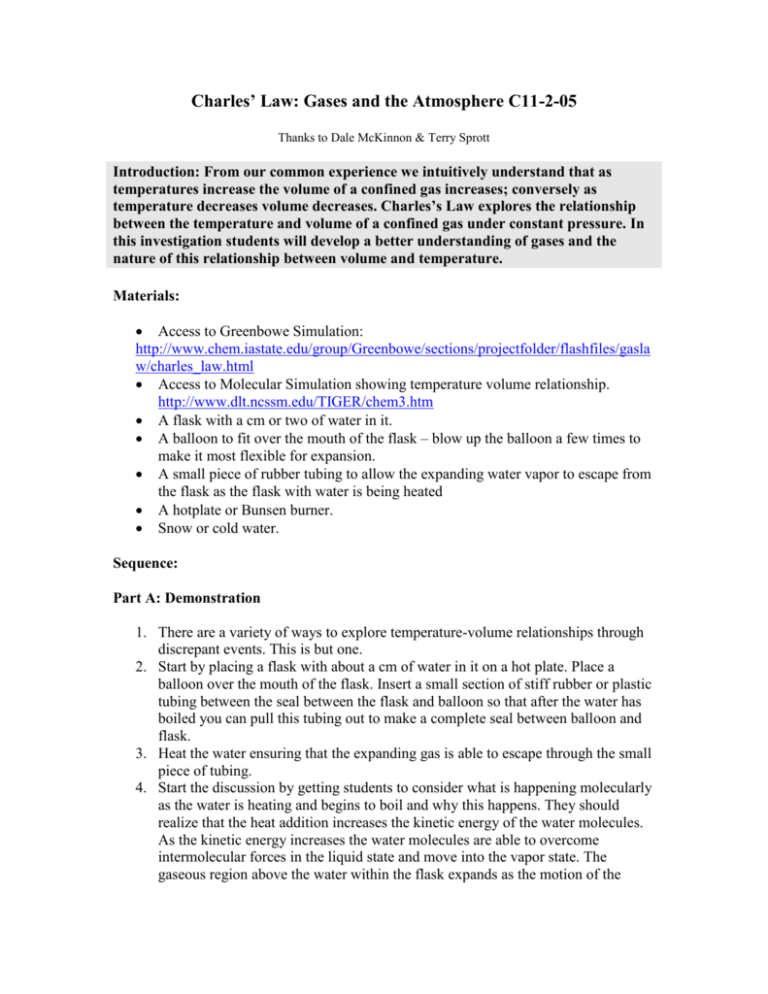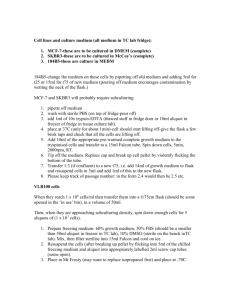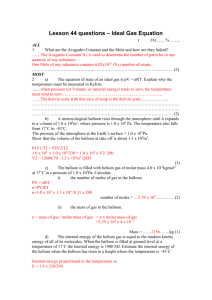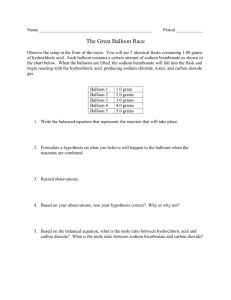Charles` Law: Gases and the Atmosphere C11-2-05
advertisement

Charles’ Law: Gases and the Atmosphere C11-2-05 Thanks to Dale McKinnon & Terry Sprott Introduction: From our common experience we intuitively understand that as temperatures increase the volume of a confined gas increases; conversely as temperature decreases volume decreases. Charles’s Law explores the relationship between the temperature and volume of a confined gas under constant pressure. In this investigation students will develop a better understanding of gases and the nature of this relationship between volume and temperature. Materials: Access to Greenbowe Simulation: http://www.chem.iastate.edu/group/Greenbowe/sections/projectfolder/flashfiles/gasla w/charles_law.html Access to Molecular Simulation showing temperature volume relationship. http://www.dlt.ncssm.edu/TIGER/chem3.htm A flask with a cm or two of water in it. A balloon to fit over the mouth of the flask – blow up the balloon a few times to make it most flexible for expansion. A small piece of rubber tubing to allow the expanding water vapor to escape from the flask as the flask with water is being heated A hotplate or Bunsen burner. Snow or cold water. Sequence: Part A: Demonstration 1. There are a variety of ways to explore temperature-volume relationships through discrepant events. This is but one. 2. Start by placing a flask with about a cm of water in it on a hot plate. Place a balloon over the mouth of the flask. Insert a small section of stiff rubber or plastic tubing between the seal between the flask and balloon so that after the water has boiled you can pull this tubing out to make a complete seal between balloon and flask. 3. Heat the water ensuring that the expanding gas is able to escape through the small piece of tubing. 4. Start the discussion by getting students to consider what is happening molecularly as the water is heating and begins to boil and why this happens. They should realize that the heat addition increases the kinetic energy of the water molecules. As the kinetic energy increases the water molecules are able to overcome intermolecular forces in the liquid state and move into the vapor state. The gaseous region above the water within the flask expands as the motion of the 5. 6. 7. 8. particles increases. Since there is an outlet through the tubing the expanding gas escapes and the balloon doesn’t inflate. As the water comes to a boil, tell students you are going to seal the flask by removing the tubing creating a perfect seal and confining the hot gas inside the flask What do they think will happen to the balloon as the temperature of the gas inside the flask cools? Students should be able to consider what will happen molecularly. Place the sealed flask on some snow and observe the rapid ‘blowing up’ of the balloon inside the flask. This will be the discrepant part of the demonstration. Students are unlikely to understand why the balloon blows up inside the flask and why it remains blown up despite not being sealed! You will likely need to illustrate this explanation. Explain to students that as the confined gas contracts because the energy of the particles decreases, the volume of the gas decreases. The atmospheric pressure external to the flask has remained constant and now begins to force the balloon inside the flask as it is greater than the pressure within the flask as the volume of the gas has decreased. Emphasize that as the temperature of the gas within the flask increased as it was heated, the volume of the gas increased causing it to escape leaving fewer gas molecules than the initial flask prior to heating. Conversely, as heat energy is removed, the kinetic energy of the gas particles decreases as evidenced in the temperature drop. A drop in temperature results in a decrease in the volume of the confined gas. Since some gas molecules have escaped the volume of gas occupied now is considerably less than prior to the heating. The pressure exerted by the external atmospheric gases now are greater than the internal gaseous pressure, thus the balloon is blown up as a result of this greater pressure. Part B: Simulation 1. Open the link: http://www.chem.iastate.edu/group/Greenbowe/sections/projectfolder/flashfi les/gaslaw/charles_law.html 2. Look at the experimental apparatus. Note there is a confined gas in a plunger (syringe) and a temperature gauge and slider to adjust temperature. 3. At the molecular level, what does the word “temperature” mean? 4. How does the addition of heat energy influence particle motion and temperature? 5. How does the addition of heat energy influence particle motion and temperature? 6. Note that by moving the temperature scale the plunger responds by moving as the volume of the confined gas changes. 7. With your knowledge of pressure explain at the molecular level why the plunger shifts upward as the temperature increases? In other words what causes the plunger to move? 8. With your knowledge of pressure explain at the molecular level why the plunger shifts downward as the temperature decreases? In other words what causes the plunger to move? Trial Number Volume Temperature Volume Temperature Relationship 1. 2. 3. 4 9. In the table below, record the volumes for at least 4 temperatures. Note that these are plotted as well as the plunger comes to rest. 10. Plot these results on the graph below. 11.Do you note any relationship? If so, what? 12.Divide the values of the volume and temperature for each ordered pair. Record this value in the third column of the chart. 13.What do you note about this value for all ordered pairs? 14.Often this Volume / temperature is expressed as V/T=k. In relationship to your data collected, what is meant by this expression? 15.As well, the expression is written as V1/T1`= V2/T2. Explain what this equation represents. 16. Return the temperature to 200 degrees K. a. What is the volume? b. You are now going to set the temperature t0 100 K. Before you do so predict what the volume will be. What do you predict the volume to be? Use the formula to assist you if necessary. 17.Repeat this prediction for some other temperatures. As an example try 100, 50 and 0 K. 18. The graph suggests that as the Temperature is increased the Volume increases. State in words the relationship between the Volume and temperature of the confined gas? 19.In both cases the relationship between the temperature and the confined gas volume is said to be direct. As one increases, the other increases. EXPLAIN AT THE PARTICLE LEVEL why the increase in temperature changes the volume. 20.EXPLAIN AT THE PARTICLE LEVEL why the decrease in temperature changes the volume. 21.This simulation has focused on developing your understanding of Charles’s Law. Express your understanding of this law: i. In words. ii. Symbolically. iii. With reference to the molecular level. 22.Provide at least three examples of where you see this relationship evidenced in everyday life.







